Submitted:
09 May 2024
Posted:
09 May 2024
Read the latest preprint version here
Abstract
Keywords:
1. Introduction
2. Fundamentals of Terahertz Antennas
3. Related Work
3.1. Metamaterial-Based Antennas
3.2. Printed and Flexible THz Antennas
3.3. Terahertz Antenna Arrays and MIMO Systems
4. Applications of Terahertz Antennas
5. Conclusion
Acknowledgements
Conflicts of Interest
References
- Wang, C.; Wei, S.; Feng, W.; Cao, J. (2022, December 21). Nonlinear dynamics of semiconductor terahertz devices. In Zhang, X.-C., Tani, M., Zhang, C., Eds.; Infrared, Millimeter-Wave, and Terahertz Technologies IX. [CrossRef]
- Bharadwaj, A.N.; Kashyap, A.M.; Bhatta, G.; Jayachandran, R.; &; Kishore, R. (2023, February 10). A Survey on Te rahertz Devices-A cutting edge Technology. 2023 International Conference on Recent Trends in Electronics and Commu nication (ICRTEC). Presented at the 2023 International Conference on Recent Trends in Electronics and Communication (ICRTEC), Mysore, India. [CrossRef]
- Hellicar, A.D.; Li, L.; Greene, K.; Hislop, G.; Hanham, S.; Nikolic, N.; & Dn, J. (2022). A 500-700 GHz system for ex ploring the THz frequency regime. In Advances in Broadband Communication and Networks (pp. 37–54). [CrossRef]
- Elaage, S.; El Ghzaoui, M.; Mrani, N.; El Alami, R.; El Alami, A.; Jamil, M.O.; & Qjidaa, H. (2023). Modeling and analysis of short distance terahertz communication channel. In Lecture Notes in Networks and Systems. Digital Technologies and Applications (pp. 289–297). [CrossRef]
- Balzer, J.C.; Saraceno, C.J.; Koch, M.; Kaurav, P.; Pfeiffer, U.R.; Withayachumnankul, W.; Kurner, T.; Stohr, A.; El-Absi, M.; Abbas, A.A.-H.; et al. THz Systems Exploiting Photonics and Communications Technologies. IEEE J. Microwaves 2022, 3, 268–288. [Google Scholar] [CrossRef]
- Malhotra, I.; & Singh, G. (2022). Terahertz imaging in healthcare. In Medical Information Processing and Security: Tech niques and applications (pp. 57–86). [CrossRef]
- Chernomyrdin, N.V.; Musina, G.R.; Nikitin, P.V.; Dolganova, I.N.; Kucheryavenko, A.S.; Alekseeva, A.I.; Wang, Y.; Xu, D.; Shi, Q.; Tuchin, V.V.; et al. Terahertz technology in intraoperative neurodiagnostics: A review. Opto-Electronic Adv. 2023, 6, 220071–220071. [CrossRef]
- Taday, P.F.; Pepper, M.; Arnone, D.D. Selected Applications of Terahertz Pulses in Medicine and Industry. Appl. Sci. 2022, 12, 6169. [Google Scholar] [CrossRef]
- Xu, L.; Zhao, X.; Bai, X. Design of on-chip antennas for THz detector and source in CMOS (Invited paper). IET Microwaves, Antennas Propag. 2023, 17, 454–466. [CrossRef]
- Armghan, A.; Aliqab, K.; Alsharari, M.; Alsalman, O.; Parmar, J.; Patel, S.K. Design and Development of Ultrabroadband, High-Gain, and High-Isolation THz MIMO Antenna with a Complementary Split-Ring Resonator Metamaterial. Micromachines 2023, 14, 1328. [Google Scholar] [CrossRef] [PubMed]
- Jin, Z.; Rong, Y.; Yu, J.; Wu, F. Design of a Compound Reconfigurable Terahertz Antenna Based on Graphene. Plasmonics 2023, 1–9. [Google Scholar] [CrossRef]
- Yordanov, P.; Priessnitz, T.; Kim, M.-J.; Cristiani, G.; Logvenov, G.; Keimer, B.; & Kaiser, S. (2022). Intense terahertz radiation via the transverse thermoelectric effect. [CrossRef]
- Didi, S.-E.; Halkhams, I.; Mohammed, F.; Balboul, Y.; Mazer, S.; & Bekkali, M.E.L. (2022). Study and design of the terahertz antenna array. In Terahertz Devices, Circuits and Systems (pp. 225–242). [CrossRef]
- Khabibullin, R. A., V. G. Mokerov Institute of Ultra High Frequency Semiconductor Electronics of the Russian Academy of Sciences, Moscow, 117105, Russian Federation, Pushkarev, S. S., Galiev, R. R., Shchavruk, N. V., Dyuzhikov, I. N., … Radio-engineering and Electronics of the Russian Academy of Sciences, Moscow, 125009, Russian Federation. (2022). Spectral characteristics of terahertz quantum cascade lasers. Nano-i Mikrosistemnaya Tehnika, 24(2), 96–102. [CrossRef]
- Bucur-Portase, R.-C. (2023). Introduction to the biological effects of terahertz radiation. In Trends in Terahertz Technology. [CrossRef]
- Pant, R.; Malviya, L. THz antennas design, developments, challenges, and applications: A review. Int. J. Commun. Syst. 2023, 36. [Google Scholar] [CrossRef]
- Maktoomi, M.H.; Saadat, S.; Momeni, O.; Heydari, P.; & Aghasi, H. (2023). Broadband antenna design for terahertz com munication systems. IEEE Access: Practical Innovations, Open Solutions, 11, 20897–20911. [CrossRef]
- Youssef, A.; Halkhams, I.; El Alami, R.; Jamil, M.O.; & Qjidaa, H. (2023). Terahertz antennas: Application, research challenges and future directions. In Lecture Notes in Networks and Systems. Artificial Intelligence and Smart Environment (pp. 757–762). [CrossRef]
- Teng, F.; Wan, J.; Liu, J. Review of Terahertz Antenna Technology for Science Missions in Space. IEEE Aerosp. Electron. Syst. Mag. 2022, 38, 16–32. [Google Scholar] [CrossRef]
- Yang, T.; Li, X.; Yu, B.; Gong, C. Design and Print Terahertz Metamaterials Based on Electrohydrodynamic Jet. Micromachines 2023, 14, 659. [Google Scholar] [CrossRef] [PubMed]
- Xing, H.; Fan, J.; Lu, D.; Gao, Z.; Shum, P.P.; Cong, L. Terahertz Metamaterials for Free-Space and on-Chip Applications: From Active Metadevices to Topological Photonic Crystals. Adv. Devices Instrum. 2022. [Google Scholar] [CrossRef]
- Ji, W.; Chang, J.; Xu, H.-X.; Gao, J.R.; Gröblacher, S.; Urbach, H.P.; Adam, A.J.L. Recent advances in metasurface design and quantum optics applications with machine learning, physics-informed neural networks, and topology optimization methods. Light. Sci. Appl. 2023, 12, 169. [Google Scholar] [CrossRef]
- Whittaker, T.; Zhang, S.; Powell, A.; Stevens, C.J.; Vardaxoglou, J.Y.C.; Whittow, W. 3D Printing Materials and Techniques for Antennas and Metamaterials: A survey of the latest advances. IEEE Antennas Propag. Mag. 2022, 65, 10–20. [Google Scholar] [CrossRef]
- Pant, R.; Malviya, L. THz antennas design, developments, challenges, and applications: A review. Int. J. Commun. Syst. 2023, 36. [Google Scholar] [CrossRef]
- Virdee, B. Grand challenges in metamaterial antennas. Front. Antennas Propag. 2022, 1. [Google Scholar] [CrossRef]
- Huang, Z.; Wu, W.; Herrmann, E.; Ma, K.; Jungfleisch, B.; Wang, X. (2022, October 3). THz metamaterials based on phase-transition materials actuated MEMS. Metamaterials, Metadevices, and Metasystems 2022.
- Shahriar, B.Y.; Carnio, B.N.; Hopmann, E.; Elezzabi, A.Y. (2022, March 7). Modification of the terahertz emission from spintronic emitters via 3D-printed structures. Terahertz, RF, Millimeter, and Submillimeter-Wave Technology and Applications XV.
- Pant, R.; Malviya, L. THz antennas design, developments, challenges, and applications: A review. Int. J. Commun. Syst. 2023, 36. [Google Scholar] [CrossRef]
- Abohmra, A.; Abbas, H.; Alomainy, A.; Imran, M.A.; Abbasi, Q.H. (2023, March 26). Flexible Terahertz Antenna Arrays Based on Graphene for Body-Centric Wireless Communication. 2023 17th European Conference on Antennas and Propagation (EuCAP). Presented at the 2023 17th European Conference on Antennas and Propagation (EuCAP), Florence, Italy.
- Li, Y.-L.; Luk, K.-M. A Low-Cost 3-D Printed THz Open Resonator Antenna. IEEE Antennas Wirel. Propag. Lett. 2022, 22, 84–88. [Google Scholar] [CrossRef]
- Chen, J.; Guo, S.; Nie, Y.; Liu, S.; & Wang, P. (2023). A flexible antenna array design for microwave energy transmission. In Lecture Notes in Electrical Engineering. Lecture Notes in Electrical Engineering (pp. 797–809). [CrossRef]
- Lai, J. , & Yang, Y. (2022, October 31). A 3D printing 120 GHz lens antenna for terahertz 1D beam-scanning applications. 2022 International Symposium on Antennas and Propagation (ISAP). Presented at the 2022 International Symposium on Antennas and Propagation (ISAP), Sydney, Australia. [CrossRef]
- Abohmra, A. , Abbas, H., Imran, M. A., & Abbasi, Q. H. (2022, July 10). Flexible antenna arrays based on graphene for high-speed THz communications. 2022 IEEE International Symposium on Antennas and Propagation and USNC-URSI Radio Science Meeting (AP-S/URSI). Presented at the 2022 IEEE International Symposium on Antennas and Propagation and USNC-URSI Radio Science Meeting (AP-S/USNC-URSI), Denver, CO, USA. [CrossRef]
- Mashayekhi, M.; Kabiri, P.; Nooramin, A.S.; Soleimani, M. A reconfigurable graphene patch antenna inverse design at terahertz frequencies. Sci. Rep. 2023, 13, 1–9. [Google Scholar] [CrossRef]
- Wang, R.; Zhu, J.; Chang, C.; Hou, L.; Zhang, Z.; Feng, Y.; Huang, Y.; Shi, W.; Wang, S.; Liang, X. Interdigitated Photoconductive Antenna Pumped by Reconfigurable Structured Light for Terahertz Emission and Modulation. IEEE Trans. Microw. Theory Tech. 2023, 71, 3661–3667. [Google Scholar] [CrossRef]
- Mutepfe, C.D.K.; Srivastava, V.M. Design and Implementation of Graphene-Based Tunable Microwave Filter for THz Applications. Nanomaterials 2022, 12, 4443. [Google Scholar] [CrossRef]
- Abd, R.H.; Abdulnabi, H.A. Reconfigurable graphene-based multi-input multi-output antenna design for THz applications. Bull. Electr. Eng. Informatics 2023, 12, 2193–2202. [Google Scholar] [CrossRef]
- Jin, Z.; Rong, Y.; Yu, J.; Wu, F. Design of a Compound Reconfigurable Terahertz Antenna Based on Graphene. Plasmonics 2023, 1–9. [Google Scholar] [CrossRef]
- Ibrahim, A.A.; Gaber, S.M. Frequency reconfigurable antipodal Vivaldi 2-port antenna based on graphene for terahertz communications. Opt. Quantum Electron. 2023, 55, 1–19. [Google Scholar] [CrossRef]
- Yang, H.; Ye, Z. Robust Adaptive Beamforming Based on Covariance Matrix Reconstruction via Steering Vector Estimation. IEEE Sensors J. 2023, 23, 2932–2939. [Google Scholar] [CrossRef]
- Mei, Y. , Li, P., Liu, K., Wang, H., Zhang, Y., Xie, R., & Rui, Y. (2022, December 9). A novel adaptive beamforming method based on steering vector and interference estimation. 2022 International Applied Computational Electromagnetics Society Symposium (ACES-China). Presented at the 2022 International Applied Computational Electromagnetics Society Symposium (ACES-China), Xuzhou, China. [CrossRef]
- Sadiq, M.; bin Sulaiman, N.; Isa, M.M.; Hamidon, M.N. A Review on Machine Learning in Smart Antenna: Methods and Techniques. TEM J. 2022, 11, 695–705. [Google Scholar] [CrossRef]
- Shi, D.; Lian, C.; Cui, K.; Chen, Y.; Liu, X. An Intelligent Antenna Synthesis Method Based on Machine Learning. IEEE Trans. Antennas Propag. 2022, 70, 4965–4976. [Google Scholar] [CrossRef]
- Tan, Y.J.; Zhu, C.; Tan, T.C.; Kumar, A.; Wong, L.J.; Chong, Y.; Singh, R. Self-adaptive deep reinforcement learning for THz beamforming with silicon metasurfaces in 6G communications. Opt. Express 2022, 30, 27763–27779. [Google Scholar] [CrossRef]
- Shihzad, W.; Ullah, S.; Ahmad, A.; Abbasi, N.A.; Choi, D.-Y. Design and Analysis of Dual-Band High-Gain THz Antenna Array for THz Space Applications. Appl. Sci. 2022, 12, 9231. [Google Scholar] [CrossRef]
- Che, M.; Kondo, K.; Kato, K. Generating and Enhancing THz Pulses via an Antenna-Coupled Unitraveling-Carrier Photodiode Array. IEEE Trans. Terahertz Sci. Technol. 2023, 13, 280–285. [Google Scholar] [CrossRef]
- Koyama, Y.; Kitazawa, Y.; Yukimasa, K.; Uchida, T.; Yoshioka, T.; Fujimoto, K.; Sato, T.; Iba, J.; Sakurai, K.; Ichikawa, T. A High-Power Terahertz Source Over 10 mW at 0.45 THz Using an Active Antenna Array With Integrated Patch Antennas and Resonant-Tunneling Diodes. IEEE Trans. Terahertz Sci. Technol. 2022, 12, 510–519. [CrossRef]
- Zarini, H.; Mili, M.R.; Rasti, M.; Andreev, S.; Nardelli, P.H.J.; Bennis, M. Intelligent Analog Beam Selection and Beamspace Channel Tracking in THz Massive MIMO With Lens Antenna Array. IEEE Trans. Cogn. Commun. Netw. 2023, 9, 629–646. [Google Scholar] [CrossRef]
- Kundu, N.K.; McKay, M.R.; Conti, A.; Mallik, R.K.; Win, M.Z. MIMO Terahertz Quantum Key Distribution Under Restricted Eavesdropping. IEEE Trans. Quantum Eng. 2023, 4, 1–15. [Google Scholar] [CrossRef]
- Magbool, A.; Sarieddeen, H.; Kouzayha, N.; Alouini, M.-S.; Al-Naffouri, T.Y. Terahertz-band Non-orthogonal Multiple Access: System- and Link-level Considerations. IEEE Wirel. Commun. 2022, 30, 142–149. [Google Scholar] [CrossRef]
- Chen, Y. , Li, R., Han, C., & Tao, M. (2022, May 16). Hybrid spherical- and planar-wave channel modeling and spatial multiplexing analysis for terahertz integrated UM-MIMO and IRS systems. ICC 2022 - IEEE International Conference on Communications. Presented at the ICC 2022 - IEEE International Conference on Communications, Seoul, Korea, Republic of. 16 May. [CrossRef]
- Bodet, D.M.; Jornet, J.M. Impact of Antenna Element Directivity and Reflection-Interference on Line-of-Sight Multiple Input Multiple Output Terahertz Systems. 2022 3rd URSI Atlantic and Asia Pacific Radio Science Meeting (AT-AP-RASC). Presented at the 2022 3rd URSI Atlantic and Asia Pacific Radio Science Meeting (AT-AP-RASC), Gran Canaria, Spain. doi:10.23919/at-ap-rasc54737.2022.9814398.
- Wang, Q.; Chen, Y.; Mao, J.; Yang, F.; Wang, N. Metasurface-Assisted Terahertz Sensing. Sensors 2023, 23, 5902. [Google Scholar] [CrossRef]
- M, K.S.; Rao, A.; Kumar, K.; Rao, T.R. Terahertz Imaging for Aerospace Applications. 2023 International Conference on Wireless Communications Signal Processing and Networking (WiSPNET). Presented at the 2023 International Conference on Wireless Communications Signal Processing and Networking (WiSPNET), Chennai, India. doi:10.1109/wispnet57748.2023.10134245.
- Morohashi, I.; Irimajiri, Y.; Kawakami, A.; Kishimoto, T.; Dat, P.T.; Kanno, A.; Sekine, N.; Hosako, I. Wireless Signal Transmission at the 2 and 3 THz-Band Enabled by Photonics-Based Transmitter and Hot Electron Bolometer Mixer. IEEE J. Sel. Top. Quantum Electron. 2023, 29, 1–7. [Google Scholar] [CrossRef]
- Chaccour, C.; Soorki, M.N.; Saad, W.; Bennis, M.; Popovski, P. Can Terahertz Provide High-Rate Reliable Low-Latency Communications for Wireless VR? . IEEE Internet Things J. 2022, 9, 9712–9729. [Google Scholar] [CrossRef]
- Thami, L.; & Ghzaoui, M.E.L. (2022). A circularly polarized wideband high gain antenna for THz wireless applications. [CrossRef]
- Pant, R.; Malviya, L. THz antennas design, developments, challenges, and applications: A review. Int. J. Commun. Syst. 2023, 36. [Google Scholar] [CrossRef]
- Teng, F.; Wan, J.; Liu, J. Review of Terahertz Antenna Technology for Science Missions in Space. IEEE Aerosp. Electron. Syst. Mag. 2022, 38, 16–32. [Google Scholar] [CrossRef]
- Mohankumar, S.; Bhairanatti, S. Reconfigurable Antenna Design for THz B and 6G Applications; Jupiter Publications Consortium: Chennai, Tamil Nadu, India, 2022. [Google Scholar]
- Tripathi, U.; Solanki, D.; Malviya, P.; Parmar, A.; Malviya, L. 2023, March 24). MIMO antenna design with PBG structure for THz communication. 2023 First International Conference on Microwave, Antenna and Communication (MAC). Presented at the 2023 First International Conference on Microwave, Antenna and Communication (MAC), Prayagraj, India.

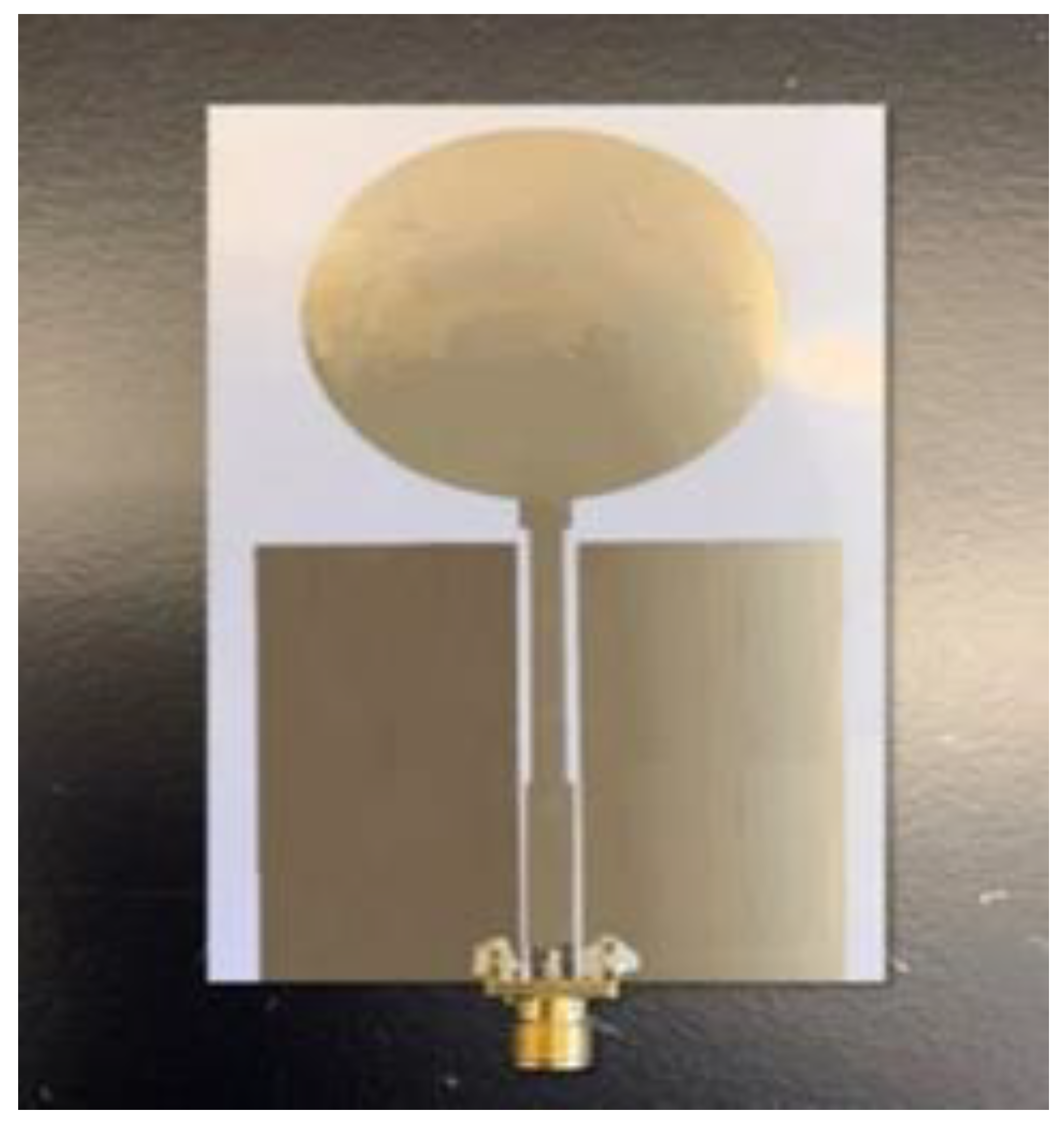

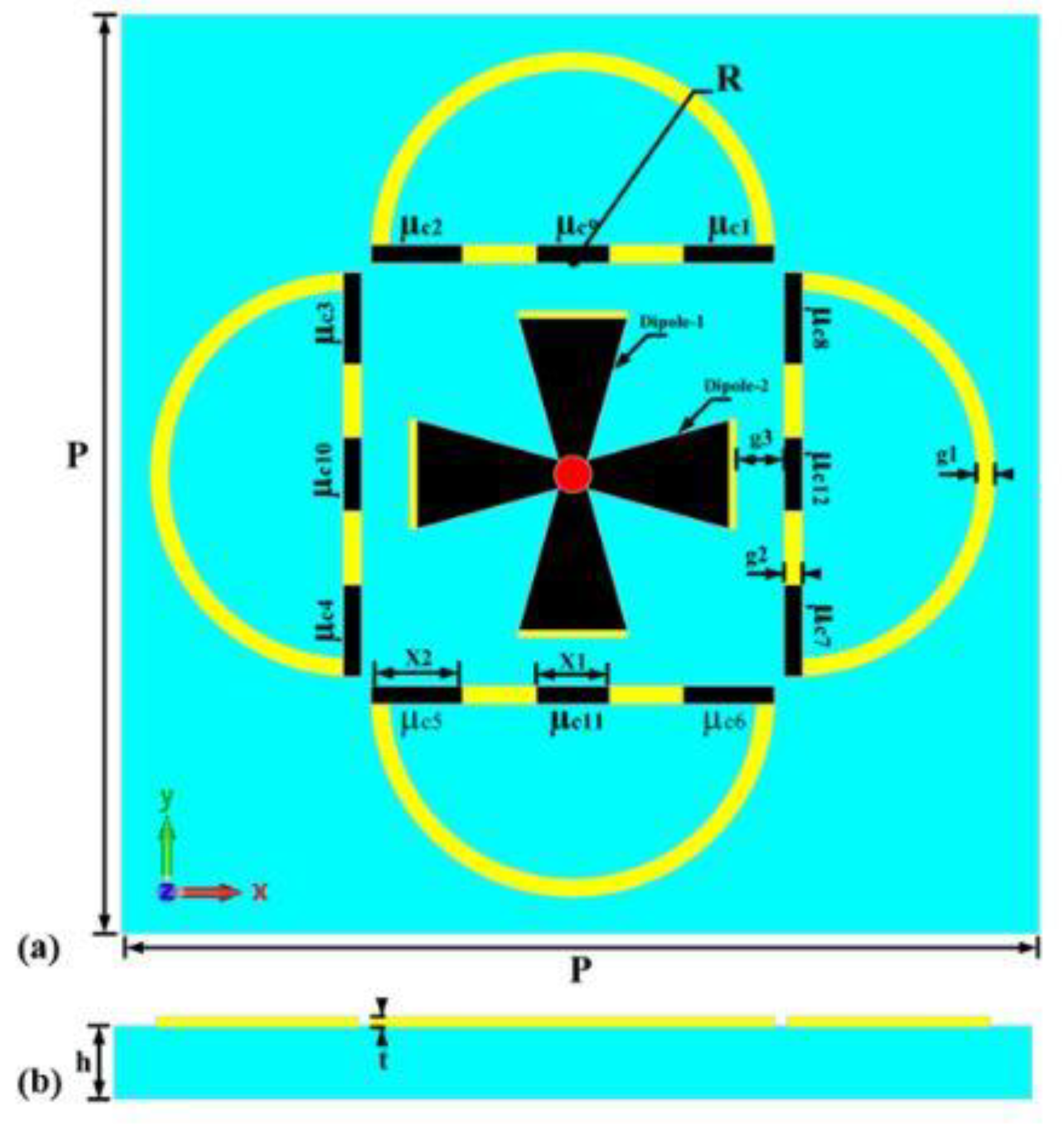
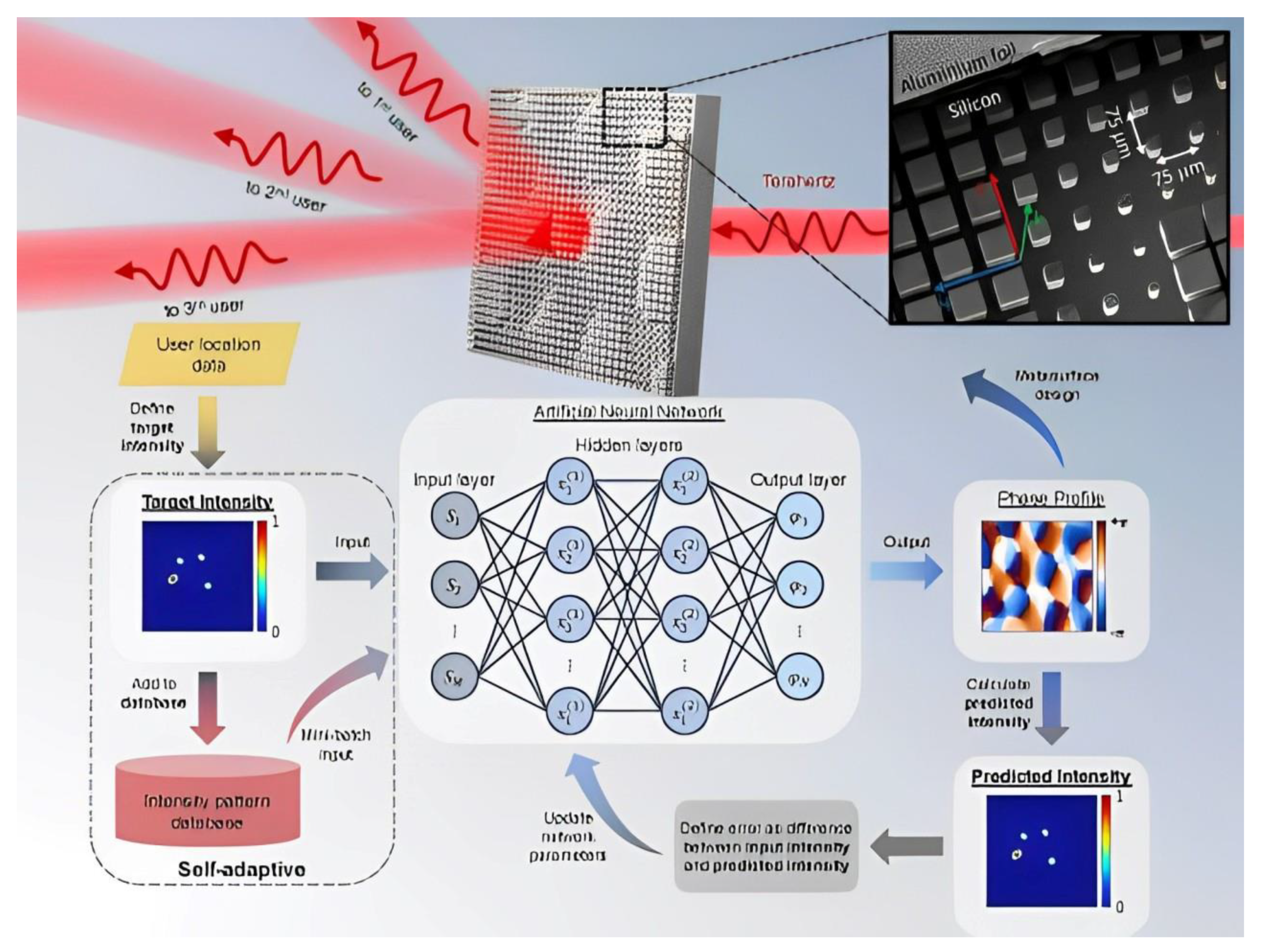
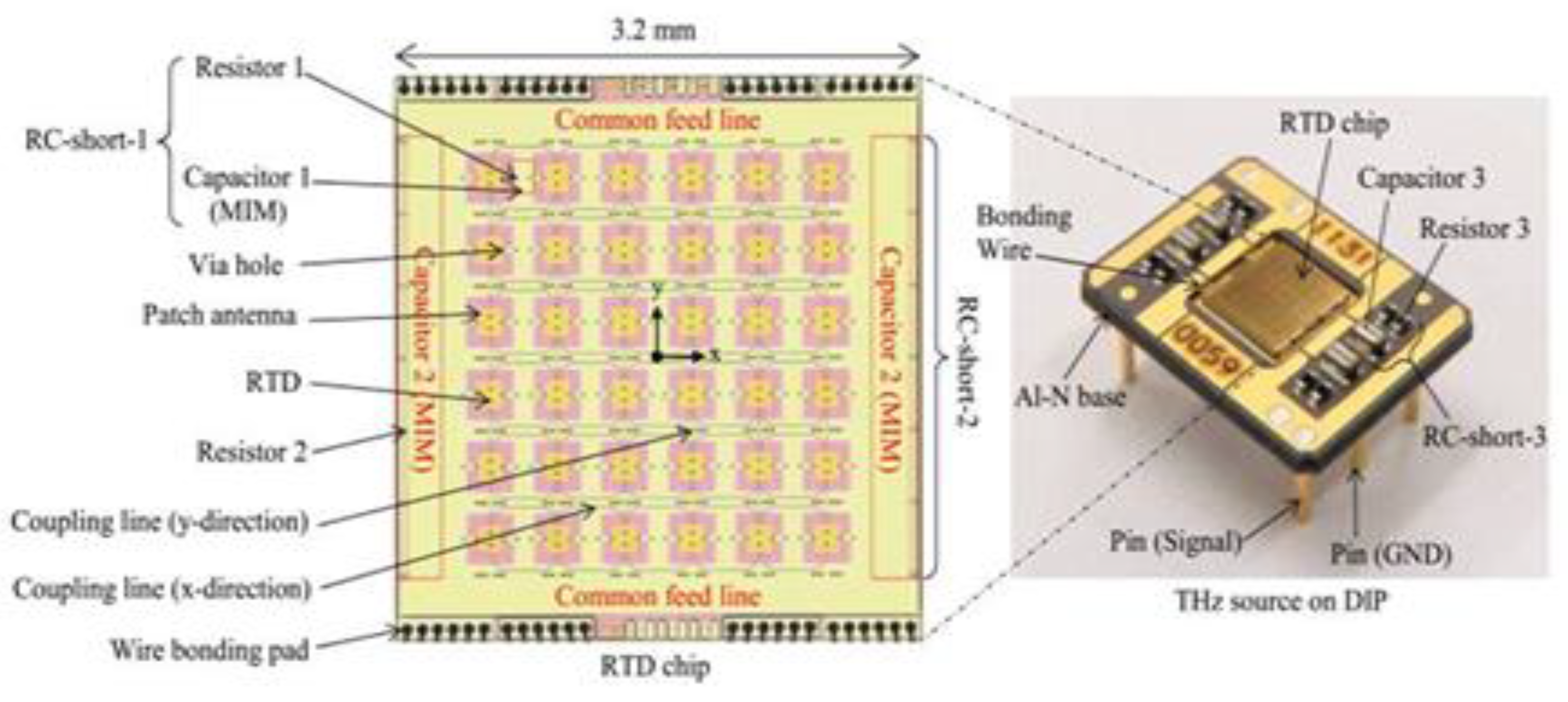
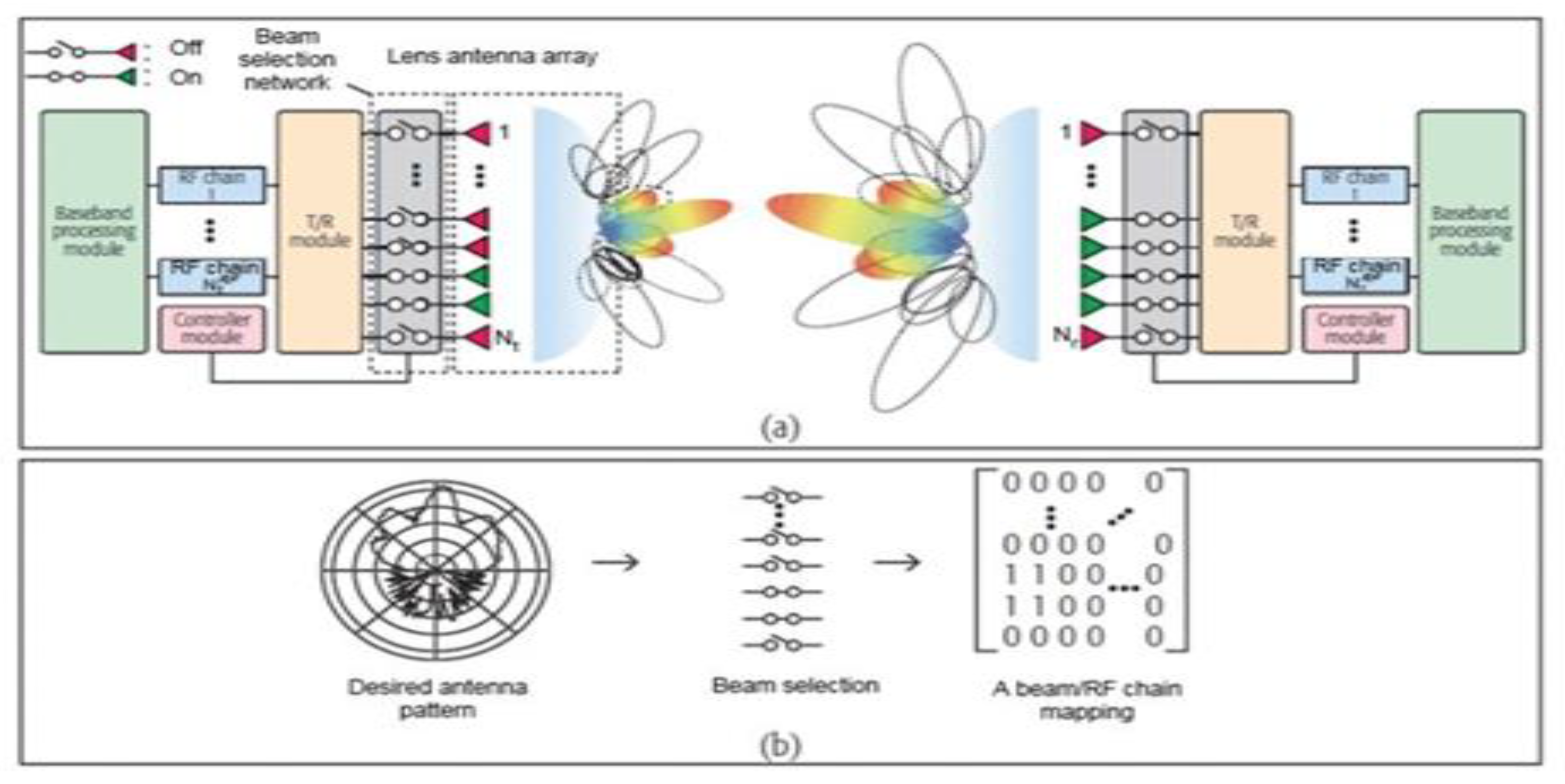
Disclaimer/Publisher’s Note: The statements, opinions and data contained in all publications are solely those of the individual author(s) and contributor(s) and not of MDPI and/or the editor(s). MDPI and/or the editor(s) disclaim responsibility for any injury to people or property resulting from any ideas, methods, instructions or products referred to in the content. |
© 2024 by the authors. Licensee MDPI, Basel, Switzerland. This article is an open access article distributed under the terms and conditions of the Creative Commons Attribution (CC BY) license (http://creativecommons.org/licenses/by/4.0/).



